Observation and Measurement of Hollow Fibres Using Digital Microscopes
A hollow fibre is a processed fibre with a hollow space. Due to the hollow space, hollow fibres are light and flexible and characterised by high heat retaining properties, water absorption properties, and quick-drying properties. Hollow fibres are used not only for apparel products but also a wide range of filtration equipment. This section introduces observation and measurement of hollow fibres using digital microscopes.
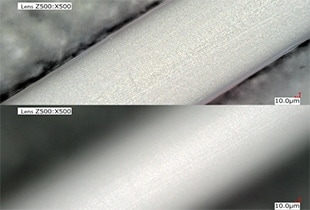
- What is a Hollow Fibre Membrane Filter?
- Use of Hollow Fibre Membrane Filters for Household Water Purifiers
- Medical Use of Hollow Fibre Membrane Filters
- Observation and Measurement Examples of Hollow Fibres Using Digital Microscopes
What is a Hollow Fibre Membrane Filter?
A hollow fibre membrane filter is made of hollow fibre membranes, which take the shape of a hollow cylinder, produced by jetting melted raw materials from a nozzle. Hollow fibre membrane walls have countless numbers of micropores.
Different components and foreign particles can be separated and extracted by adjusting the diameter of these pores.
Use of Hollow Fibre Membrane Filters for Household Water Purifiers
Water purifiers commonly used activated carbon until the first half of the 1980s. Since then, use of filters that combine activated carbon and hollow fibre membranes has spread. Hollow fibre membranes are thin straw-like fibres made from artificial polymers, such as polysulfone, polyethylene, or polypropylene, that are bundled to form a filter. Membrane walls have micropores that absorb impure substance particles.
Activated carbon absorbs residual chlorine, chlorine odour, mould odour, trihalomethanes, agricultural chemicals, and other unwanted substances, and hollow fibre membranes eliminate iron rust, bacteria, turbidity, and other unwanted substances.
Medical Use of Hollow Fibre Membrane Filters
Hollow fibre membrane filters are also used for various applications in the medical field.
Major application examples
- Artificial kidney (dialyser)
- Hollow fibres in artificial kidneys used for artificial dialysis have pores with a diameter of approximately five nanometres. As red blood cells, white blood cells, and many plasma proteins are larger than the pore diameter, only excess water and uremic substances (waste products) exit from hollow fibres.
- Plasma separator
- Pores with a diameter of approximately 300 nanometres can separate blood cell components, such as red blood cells and platelets, from plasma components containing proteins.
- Plasma component separator
- Plasma component separators incorporate hollow fibres with pore diameters controlled to specific sizes, such as approximately 10 nanometres, 20 nanometres, or 30 nanometres.
Observation and Measurement Examples of Hollow Fibres Using Digital Microscopes
These are the latest examples of observation and measurement of hollow fibres using KEYENCE’s VHX Series 4K Digital Microscope.
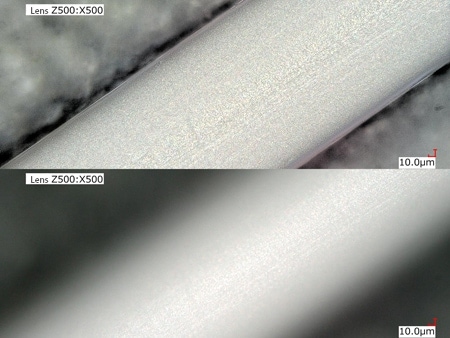
Upper: Depth composition Lower: Normal image
Using the HDR with depth composition allows for defect analysis without using a scanning electron microscope (SEM).
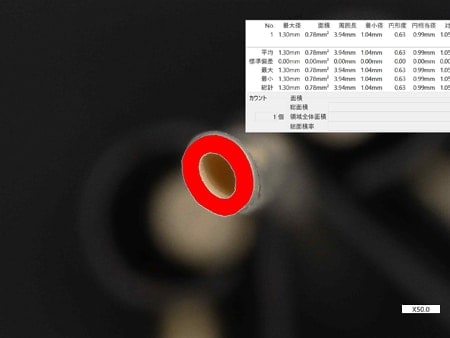
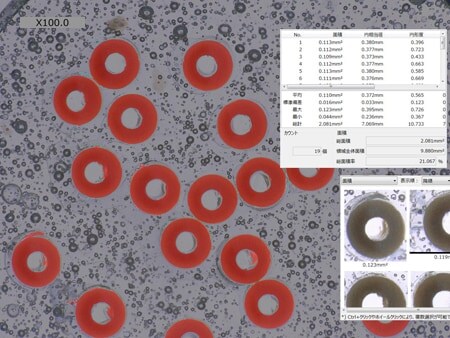
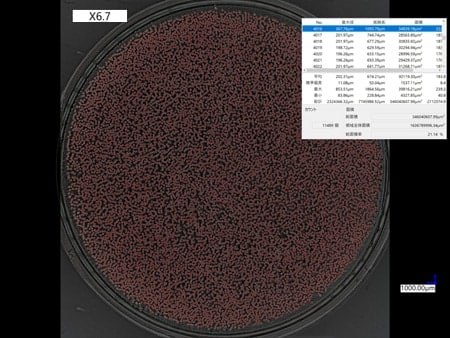
The HDR function can accurately count the number of fibres and evaluate the inner and outer diameters.


